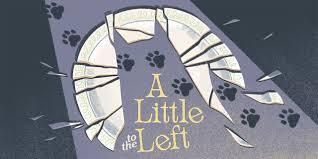“A Little to the Left” is an indie puzzle game developed by Max Inferno that challenges players to organize and arrange household items to achieve a sense of order and satisfaction. Released in 2022, the game offers a cozy, visually pleasing experience that emphasizes relaxation and creativity. It stands out in the crowded puzzle genre with its unique concept and charming art style.
Concept and Theme
At its core, “A Little to the Left” is a game about tidying up. The premise is simple yet engaging: players are presented with various everyday scenes and objects, which they must organize in a way that feels right. The game taps into the universal desire for order and the satisfying feeling that comes with arranging things neatly. This theme is subtly therapeutic, offering a calming and meditative experience that contrasts with the high-energy demands of many other games.
Gameplay Mechanics
1. Puzzle Structure: The game is structured around a series of puzzles that range from organizing books on a shelf to arranging kitchen utensils. Each puzzle has a specific goal, such as aligning objects symmetrically or sorting items by size or color. The solutions are often open-ended, allowing players to use their creativity to find multiple correct answers.
2. Interaction: Players interact with the game using simple drag-and-drop mechanics. This intuitive control scheme makes the game accessible to a wide audience, including those who might not be regular gamers. The tactile nature of moving objects around the screen mimics the real-life satisfaction of tidying up.
3. Challenges and Variability: While the game is designed to be relaxing, it also introduces variability and challenges to keep players engaged. Some puzzles have hidden solutions that require players to think outside the box. The game also features random events, such as a mischievous cat that disrupts the player’s progress, adding a playful element of surprise.
4. Progression and Rewards: As players complete puzzles, they unlock new levels and more complex challenges. The sense of progression is gradual, ensuring that the difficulty curve remains manageable. The game rewards players with satisfying animations and sounds when they successfully organize a scene, reinforcing the sense of accomplishment.
Visual and Audio Design
1. Art Style: “A Little to the Left” features a charming, hand-drawn art style that enhances its cozy and inviting atmosphere. The visuals are clean and minimalist, focusing on the details of everyday objects. The color palette is soft and warm, contributing to the overall sense of calm.
2. Soundtrack: The game’s soundtrack plays a crucial role in setting the mood. It features soothing, ambient music that complements the visual aesthetics. The sound effects, such as the gentle clinking of items being placed and the rustling of pages, are subtle yet effective in enhancing the tactile experience of organizing.
Narrative and Emotional Impact
1. Story Elements: While “A Little to the Left” is primarily a puzzle game, it also weaves in subtle narrative elements. Through the objects and scenes players interact with, snippets of a larger story about the inhabitants of the house are revealed. This narrative layer adds depth to the gameplay, making the player feel connected to the space they are organizing.
2. Emotional Resonance: The game’s emphasis on order and organization resonates with players on an emotional level. It taps into the intrinsic satisfaction of creating harmony out of chaos. This emotional connection is particularly powerful in a world that often feels cluttered and chaotic, offering players a digital sanctuary of order and calm.
Development and Inspiration
1. Developer Background: Max Inferno, the indie studio behind “A Little to the Left,” drew inspiration from their personal experiences and the universal appeal of tidying up. The developers aimed to create a game that was both relaxing and engaging, focusing on the small, everyday moments that bring joy.
2. Design Philosophy: The design philosophy behind the game emphasizes simplicity and creativity. The developers wanted to ensure that the game was accessible to everyone, regardless of their gaming experience. This inclusive approach is reflected in the game’s intuitive controls and open-ended puzzles.
Reception and Impact
1. Critical Acclaim: “A Little to the Left” has been well-received by critics and players alike. It has been praised for its unique concept, charming art style, and calming gameplay. Reviewers have highlighted the game’s ability to provide a sense of relaxation and satisfaction, making it a standout title in the puzzle genre.
2. Player Community: The game has fostered a supportive and enthusiastic community of players who share their own solutions to puzzles and discuss their favorite moments. This community aspect adds another layer of enjoyment, as players can connect with others who appreciate the game’s unique charm.
3. Awards and Recognition: “A Little to the Left” has received several awards and nominations, recognizing its innovative gameplay and artistic design. These accolades have helped to raise the game’s profile and attract a broader audience.
Comparison with Other Puzzle Games
1. Unique Selling Points: What sets “A Little to the Left” apart from other puzzle games is its focus on everyday objects and the satisfaction of tidying up. While many puzzle games challenge players with complex logic or spatial reasoning tasks, this game offers a more intuitive and emotionally resonant experience.
2. Complementary Titles: Other games that share a similar ethos of relaxation and creativity include “Unpacking,” which also involves organizing and arranging items, and “Hidden Folks,” which features hand-drawn art and interactive environments. These games, like “A Little to the Left,” offer a break from the intensity of more traditional gaming experiences.
Future Updates and Potential
1. Planned Updates: Max Inferno has expressed interest in continuing to support “A Little to the Left” with additional content and updates. This could include new puzzles, seasonal events, and quality-of-life improvements based on player feedback.
2. Expanding the Experience: There is potential for the game to expand its scope, perhaps by introducing new settings or more complex organizational challenges. The developers could also explore collaborations with other artists to bring fresh perspectives to the game’s design.
Conclusion
“A Little to the Left” is a delightful and engaging puzzle game that stands out for its unique concept, charming art style, and calming gameplay. It offers players a digital sanctuary where they can indulge in the simple pleasure of tidying up, creating order out of chaos. The game’s success lies in its ability to tap into universal human experiences and emotions, providing a soothing and satisfying escape from the hustle and bustle of everyday life. Whether you’re a seasoned gamer or new to the genre, “A Little to the Left” is a must-play that will leave you feeling relaxed and fulfilled.




